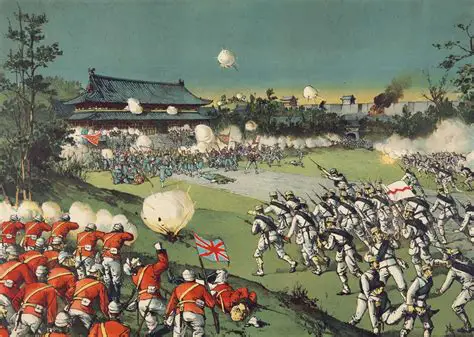The Boxer Rebellion, a pivotal event in Chinese history, erupted in 1899 and profoundly impacted the nation’s political, social, and economic landscape. Spanning over two years, the rebellion pitted the Chinese people against foreign powers and their influence, culminating in widespread violence and turmoil.

Roots of Discontent
The Boxer Rebellion did not emerge in isolation but was the culmination of growing discontent among the Chinese population. Foreign powers had been encroaching upon Chinese sovereignty for decades, establishing spheres of influence and exploiting the country’s resources. The influx of Christian missionaries and the perceived threat to Chinese cultural traditions further fueled resentment.
Economic hardships also played a role in the rebellion. China was suffering from severe droughts and floods, leading to widespread poverty and hunger. The government’s inability to address these issues intensified the population’s frustration and made them receptive to the Boxer movement’s promises of prosperity.
The Boxer Movement
The Boxer Rebellion was spearheaded by the Society of Righteous and Harmonious Fists, a secret society known as the Boxers. They believed in a mystical power that made them invulnerable to foreign weapons. The Boxers espoused a xenophobic ideology, targeting Christian missionaries and foreign businesses.
The movement gained widespread support in China’s rural areas, where the population flocked to the Boxers’ promises of protection and wealth. The Boxers used martial arts, magical rituals, and secret codes to instill fear and loyalty among their followers.
Outbreak of Violence
In the spring of 1900, the Boxer Rebellion erupted in the northern province of Shandong. The Boxers began attacking Christian missions and foreign settlements, killing missionaries and Chinese converts. The violence quickly spread to Beijing, where the Boxers besieged the foreign legations.
The Qing government, initially hesitant to confront the Boxers, was forced to take action as the rebellion threatened to overthrow the dynasty. The Empress Dowager Cixi declared war on foreign powers, and the siege of the legations commenced.
Foreign Intervention
The escalating violence and the threat to foreign lives prompted eight foreign powers to intervene. A coalition of troops from Britain, France, Germany, Italy, Japan, Russia, the United States, and Austria-Hungary was assembled to crush the rebellion.
The foreign powers fought their way into Beijing and lifted the siege of the legations. The Boxer movement was brutally suppressed, with thousands of Boxers and their supporters being killed. The Empress Dowager Cixi was forced to flee the capital, and the Qing dynasty was dealt a severe blow.
Consequences of the Boxer Rebellion
The Boxer Rebellion had far-reaching consequences for China:
-
Political: The rebellion weakened the Qing dynasty and accelerated its decline. The foreign powers increased their influence in China, imposing punitive measures and establishing spheres of influence that further eroded Chinese sovereignty.
-
Social: The Boxer Rebellion resulted in the deaths of over 100,000 people, including missionaries, Chinese converts, and Boxers. The violence and destruction intensified xenophobia and anti-foreign sentiment in China.
-
Economic: The rebellion disrupted trade and commerce, leading to economic losses. The foreign powers demanded compensation for damages, further burdening the Chinese economy.
Lessons from the Boxer Rebellion
The Boxer Rebellion serves as a cautionary tale about the dangers of xenophobia, extremism, and government complacency. It underscores the importance of addressing societal grievances and fostering inclusive and tolerant societies.
Tables
| Table 1: Foreign Casualties in the Boxer Rebellion |
|—|—|
| Country | Deaths |
| Britain | 118 |
| France | 113 |
| Germany | 103 |
| Italy | 58 |
| Japan | 57 |
| Russia | 36 |
| United States | 25 |
| Austria-Hungary | 1 |
| Table 2: Chinese Casualties in the Boxer Rebellion |
|—|—|
| Group | Deaths (estimated) |
| Boxers | 50,000-100,000 |
| Chinese civilians | 20,000-30,000 |
| Foreign missionaries and converts | 2,000-3,000 |
| Table 3: Foreign Punitive Expeditions After the Boxer Rebellion |
|—|—|
| Country | Action |
| Britain | Occupied Weihaiwei |
| France | Occupied Guangzhouwan |
| Germany | Acquired Jiaozhou Bay |
| Italy | Occupied Sanmen Bay |
| Japan | Acquired Liaodong Peninsula |
| Russia | Acquired Port Arthur and Darien |
| United States | Acquired Guam and the Philippines |
| Table 4: Key Figures in the Boxer Rebellion |
|—|—|
| Empress Dowager Cixi | Leader of the Qing dynasty |
| Rong Lu | Grand Secretary |
| Yuan Shikai | Governor of Shandong |
| Cixi | Empress Dowager Cixi |
| Prince Duan | Cixi’s nephew and leader of the Boxers |
| John Hay | US Secretary of State |
